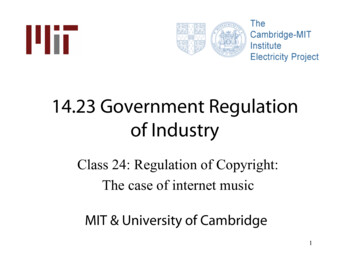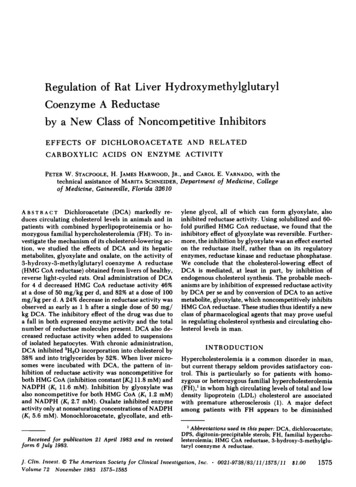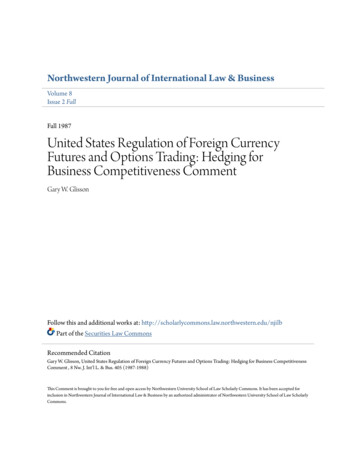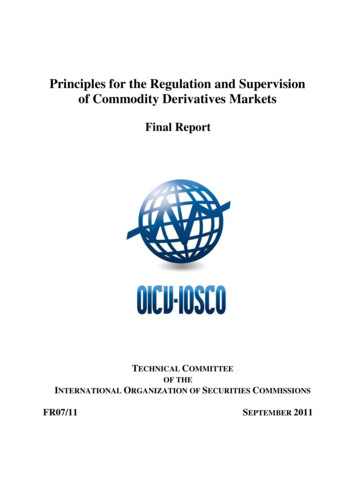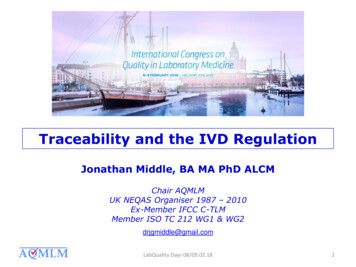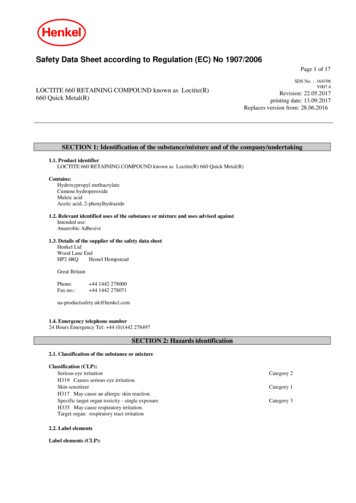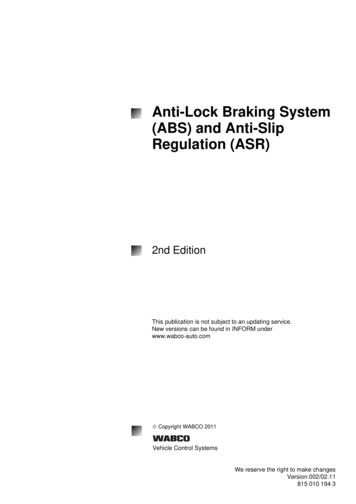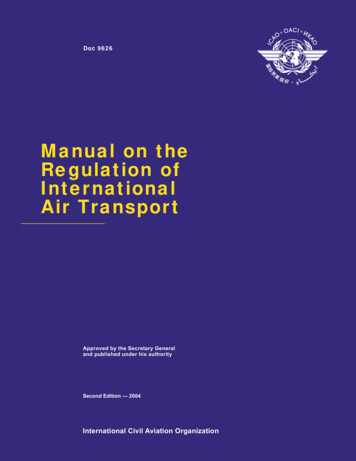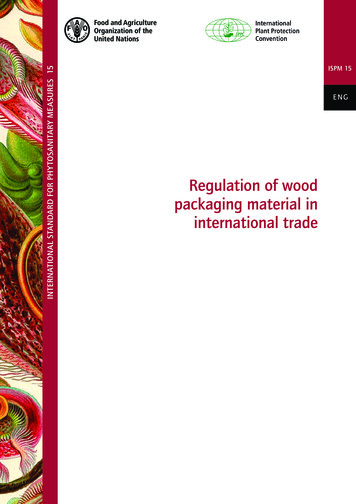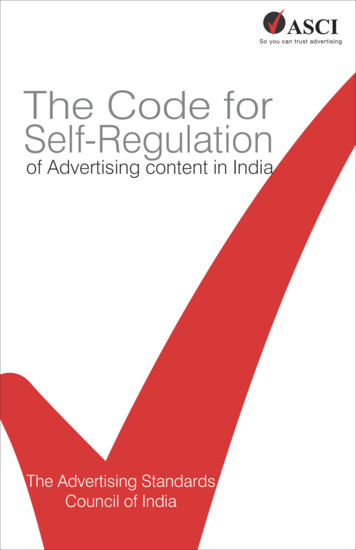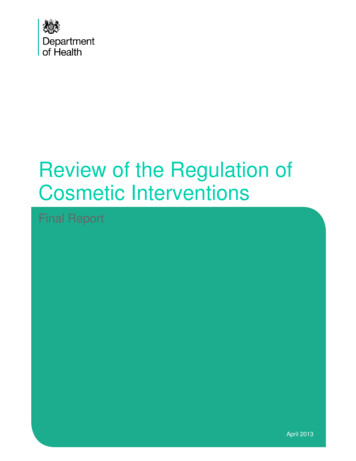
Transcription
Review of the Regulation ofCosmetic InterventionsFinal ReportApril 2013
You may re-use the text of this document (not including logos) free of charge in any format ormedium, under the terms of the Open Government Licence. To view this licence, nt-licence/ Crown copyrightPublished to gov.uk, in PDF format only.www.gov.uk/dh2
Review of the Regulation ofCosmetic InterventionsFinal ReportPrepared by the Review Committee3
ContentsContents. 4Foreword . 5Executive Summary . 7Introduction . 9Overarching Objectives . 13High Quality Care . 15Ensuring Safe Products . 29Informed and Empowered Public . 35Responsible Advertising and Marketing . 40Accessible Resolution and Redress . 44Appendix 1 . 49Appendix 2 – Risks of dermal fillers . 51Appendix 3 – Risks posed by laser treaments . 53Appendix 4 . 56Glossary . 58References . 634
ForewordThis group was asked to review regulation in the cosmetic interventions sector following the PIPimplant scandal which exposed woeful lapses in product quality, after care and record keeping.It also drew attention to widespread use of misleading advertising, inappropriate marketing andunsafe practices right across the sector. Cosmetic interventions are a booming business in theUK, worth 2.3 billion in 2010, and estimated to rise to 3.6 billion by 2015. They can either besurgical – such as face-lifts, tummy tucks and breast implants – or non-surgical – typicallydermal fillers, Botox or the use of laser or intense pulsed light (IPL). These latter account fornine out of ten procedures and 75% of the market value. We were surprised to discover thatnon-surgical interventions, which can have major and irreversible adverse impacts on healthand wellbeing, are almost entirely unregulated.In fact, a person having a non-surgical cosmetic intervention has no more protection andredress than someone buying a ballpoint pen or a toothbrush.Dermal fillers are a particular cause for concern as anyone can set themselves up as apractitioner, with no requirement for knowledge, training or previous experience. Nor are theresufficient checks in place with regard to product quality – most dermal fillers have no morecontrols than a bottle of floor cleaner. There has been explosive growth in this market, driven bya combination of high demand and high profits in an era when all other commercial income isstalling.It is our view that dermal fillers are a crisis waiting to happen.Previous attempts at self-regulation in the industry have failed, largely because voluntary codeshave meant that only the best in this disparate sector commit themselves to better practice,whilst the unscrupulous and unsafe carry on as before.Throughout our meetings, discussions and correspondence with stakeholders from all groups,professions and experts, the call has been for a new legislative framework. Taken together, ourrecommendations provide that framework for both surgical and non-surgical interventions. Theyset out a range of actions to ensure practitioners have the right skills, the products used aresafe, providers are responsible, people get accurate information and support is available ifthings go wrong.These recommendations are not about increasing bureaucracy but about putting the everyone’ssafety and wellbeing first.5
Review of the Regulation of Cosmetic InterventionsForewordThose having cosmetic interventions are often vulnerable. They take their safety as a given andassume regulation is already in place to protect them. We urge the government, regulators,provider organisations and professionals to help implement these recommendations and tomake sure that individuals’ health and safety is prioritised ahead of commercial interest, somaintaining the trust and safety of the public and the future viability of this industry.Professor Sir Bruce Keogh KBEOn behalf of the Review Committee members:Ms Trish HalpinDr Rosemary LeonardDr Andrew Vallance-OwenProf. Sir Ian KennedyMrs Vivienne ParryMr Simon WitheyMs Catherine KyddProf. Shirley Pearce6
Executive SummaryThe cosmetic interventions sector is growing rapidly. The existing regulatory framework has notkept pace with changes and it does not provide enough protection against many of the potentialrisks from cosmetic procedures.The Review Committee has gathered evidence from those in the sector, the public, academicsand international policy makers and believes that better regulation is needed to bring theindustry into line with those in other countries and align this sector with comparable publichealth and consumer practice in this country.There are three key areas in which changes are needed: high quality care with safe products,skilled practitioners and responsible providers; an informed and empowered public to ensurepeople get accurate advice and that the vulnerable are protected; and, accessible redress andresolution in case things go wrong.The Review Committee’s recommendations aim to ensure these changes can occur. Takentogether they form a new legislative framework that is proportionate to the potential risks ofcosmetic interventions.Key recommendations:High quality care The scope of the EU Medical Devices Directive should be extended to include allcosmetic implants including dermal fillers, UK legislation should be introduced toenact the changes sooner. Legislation should be introduced to classify fillers as aprescription-only medical device. The Royal College of Surgeons (RCS) should establish an Interspecialty Committeeon Cosmetic Surgery, made up of representatives of all the relevant specialty andprofessional associations. The purpose of this group is to set standards for cosmeticsurgery practice and training, and make arrangements for formal certification of allsurgeons regarded as competent to undertake cosmetic procedures, taking accountof training and experience. All those performing cosmetic interventions must be registered. The Health Education England’s (HEE’s) mandate should include the developmentof appropriate accredited qualifications for providers of non-surgical interventionsand it should determine accreditation requirements for the various professionalgroups. This work should be completed in 2013. Surgical providers should provide both the person undergoing a procedure and theirGP with proper records.7
Review of the Regulation of Cosmetic InterventionsExecutive Summary A breast implant registry should be established within the next 12 months andextended to other cosmetic devices as soon as possible, to provide better monitoringof patient outcomes and device safety.An informed and empowered public The RCS Interspecialty Committee on Cosmetic Surgery should develop anddescribe a multi-stage consent process for operations. Consent must be taken bythe surgeon performing the operation to ensure that the patient and practitioner havea shared understanding of the desired outcome and the limitations, implications andrisks of the procedure. Evidence-based standardised patient information should be developed by the RCSInterspecialty Committee on Cosmetic Surgery, with input from patient organisations. For non-surgical procedures a record of consent must be held by the provider. Existing advertising recommendations and restrictions should be updated and betterenforced. The use of financial inducements and time-limited deals to promote cosmeticinterventions should be prohibited to avoid inappropriate influencing of vulnerableconsumers.Accessible resolution and redress The remit of the Parliamentary and Health Service Ombudsman (PHSO) should beextended to cover the whole private healthcare sector. This will de facto includecosmetic procedures of all kinds. All individuals performing cosmetic procedures must possess adequate professionalindemnity cover that is commensurate with the type of operations being performed.For surgeons working in this country, but who are insured abroad, indemnityinsurance must be commensurate with similar UK policies. The Review Committee supports the future development of insurance products suchas risk pool arrangements, to cover product failure and certain complications ofsurgery.8
1. Introduction1.1.The events surrounding Poly Implant Prothèse (PIP) silicone breast implants raisedspecific issues regarding the safety and regulation of cosmetic surgery. The Departmentof Health convened an expert group to develop advice on PIP implants1 and asked EarlHowe to review the response of the Department and MHRA2.1.2.This process exposed wider, serious concerns about the regulation of cosmeticinterventions – for example, why were unsafe products on the market; why was it sodifficult to reliably trace people who had received cosmetic implants; were vulnerablepeople put under inappropriate pressure to have cosmetic procedures; and were theyproperly informed about the risks?1.3.Existing regulations were not designed to encompass the changes seen in the cosmeticinterventions industry, which is evolving and expanding very rapidly. In 2005, thecosmetic sector was worth 720m, by 2010 it was valued at 2.3bn and by 2015 thesector is forecast to grow to a value of 3.6bn3.1.4.Demand has been driven by a wide range of social, economic and technological factors.Cosmetic interventions have been normalised4. Previously undertaken discretely, nowpeople will admit to having had procedures and even celebrate them. Men are alsoincreasingly likely to consider having a cosmetic intervention5.1.5.Advances in technology mean an ever-growing range of interventions or treatments areavailable, many of these are quicker and less invasive than past procedures. Themajority of the market growth has been seen in the non-surgical interventions sector3,which is lightly regulated, despite known risks to the consumer6.1.6.Technology has also changed how these procedures are marketed: social media havebeen cited as a key driver of market growth, particularly among younger people4. Thepervasiveness and accessibility of images, advertising and celebrity endorsementsthrough the internet have encouraged changing attitudes and growth of the industry.1.7.In light of concerns about the whole cosmetic interventions industry, both surgical andnon-surgical, the then Secretary of State for Health, the Rt Hon Andrew Lansley MP,asked Professor Sir Bruce Keogh, the NHS Medical Director, to review how the safety ofpeople considering or undergoing cosmetic interventions might be better ensured7. Tohelp achieve this goal, Sir Bruce set up a Review Committee with broad membership(see Appendix 1), to provide him with expert advice.9
Review of the Regulation of Cosmetic Interventions1.8.1.9.The Review’s Terms of Reference asked it to consider in particular: whether the regulation of the products used in such interventions is appropriate; how best to assure patients and consumers that the people who carry outprocedures have the skills to do so; how to ensure that the organisations which deliver such procedures have the clinicalgovernance systems to assure the care and welfare of people who use theirservices; how to ensure that people considering such interventions are given the information,advice and time for reflection to make an informed choice; whether there should be a statutory requirement for such organisations to offerredress in the event of harm, and if so how this could be funded; what improvements are needed in systems for reporting patient outcomes, includingadverse events, for central analysis and surveillance.In examining these issues, the Review Committee has considered the findings of otherswho have looked at this area. In 2005, Sir Harry Cayton chaired an Expert Group on theRegulation of Cosmetic Surgery, which made recommendations to the Chief MedicalOfficer, focussed on improving safety through increasing specialist training andaccountability8. The National Confidential Enquiry into Patient Outcome and Death(NCEPOD) published the report On the Face of It in 2010, which exposed failings ofmany providers, including a lack of appropriate facilities, lack of clarity regardingsurgeons’ competence, and a lack of support to help patients understand the risks ofprocedures9. This year the Royal College of Surgeons brought together a range ofexisting standards into one document, Professional Standards for Cosmetic Practice10.1.10. The regulation of cosmetic interventions is not just a challenge for England; othergovernments are considering how best to ensure quality and safety in this rapidlyexpanding area and the Review Committee has considered their approaches. In 2010the Australian Health Ministers’ Advisory Council published its findings which proposed aNational Framework including new training standards and tighter enforcement ofadvertising restrictions11. In Hong Kong, the government is conducting a review aboutwhere the line should be drawn between beauty therapy procedures and medicaltreatments12. Denmark has introduced new regulations addressing who can performcosmetic procedures13 and Sweden announced in December that it is considering similarproposals. At a European level, new voluntary standards are currently being developedfor aesthetic surgery and non-surgical medical services which cover the requiredcompetencies, consent and complaints processes14.10
Review of the Regulation of Cosmetic Interventions1.11. The Review Committee has considered these reports, their findings and their impact. Inaddition, a Call for Evidence15 was issued to gather the views of the industry, public andwider stakeholders. The Committee and its Secretariat have met with many stakeholdersfrom all sectors and have sought the advice of a wide range of experts.1.12. In general, there is a concerning lack of data in this sector. There is also a limitedknowledge of the views, understanding and attitudes of people undergoing theseprocedures. Therefore, the Review Committee commissioned additional research intopublic attitudes towards the regulation and safety of cosmetic interventions, andconsulted experts regarding psychological assessment and aids to predictors andoutcomes of cosmetic interventions.1.13. The Review Committee has taken a broad view of cosmetic interventions. It hasconsidered the issues relating to those procedures that are carried out for aesthetic andfunctional reasons. While not every procedure will be named in this report, the principlesset out are intended to apply across the sector. The Review Committee intends that thisapproach will ensure that its recommendations will remain relevant as new proceduresemerge.Our Approach1.14. The cosmetic interventions sector is highly fragmented. It encompasses an enormousrange of procedures, from relatively minor interventions to major surgery. There is a widerange of different interest groups, including product manufacturers, practitioners andthose who provide premises and facilities, and there is no single professional or tradeorganisation that represents all these groups. The rapid growth and diversification of thesector is compounding the difficulties of quality control.1.15. Existing legislation in this area has developed in a piecemeal fashion, addressing certainaspects of the sector but not taking a systematic approach. Attempts at self-regulationhave largely failed because of the diversity of the sector and the lack of mandation.1.16. Cosmetic interventions can have a profound impact on health and wellbeing16. In otherareas of life where this is the case, regulation provides safeguards to reduce harm.However, in the case of dermal fillers, the treatments are almost entirely unregulated –anyone can perform them, anywhere and with any product – this is a crisis waiting tohappen.1.17. There is also a need for greater protection for vulnerable people. Cultural changes haveplaced much greater emphasis on physical perfection. Young people and girls inparticular, are becoming more and more concerned with their appearance.11
Review of the Regulation of Cosmetic InterventionsSource: The Girl Guides Association, Girls’ Attitudes, 2012.1.18. The Review Committee’s attitudinal research suggested younger people see cosmeticprocedures as a commodity – something they might ‘get done’4. This can be attributed inpart to the use of social media and the growth in celebrity culture: 41% of girls aged 7 to10 and 62% aged 11 to 16 said they felt some pressure to look the way celebrities do17.1.19. The Review Committee has not made judgements about whether the growth in cosmeticinterventions is good or bad. Its approach has been to ensure that there is a frameworkto protect patients and enable consumers to choose.12
Review of the Regulation of Cosmetic Interventions2. Overarching objectives2.1.Having reviewed the evidence, the Committee believes the government needs toestablish a regulatory framework that encompasses the whole sector, employing a clear,consistent and proportionate approach that is able to adapt to new developments. TheReview Committee believes that any new regulations must meet certain overarchingobjectives.High quality care2.2.First and foremost, people should receive high quality care when they choose to undergoa cosmetic procedure. In England, the quality of healthcare is defined and assessed byits effectiveness, safety and patients’ experience18. For cosmetic procedures, this meansthe products used should be safe, the practitioners should have the appropriate skills andtraining, the premises must be suitable, and those undergoing procedures must betreated with respect.An informed and empowered public2.3.People choosing to undergo cosmetic interventions are both patients and consumers.They are making purchasing decisions on procedures and products that may have asignificant impact on their health and wellbeing. It is essential that people are helped tomake informed decisions based on clear, easily accessible and unbiased information anddata. Management of the expectation of individuals who are considering a cosmeticintervention must be part of the consent process.Accessible resolution and redress2.4.In the event of medical complications, or where poor clinical care leads to substandardoutcomes, practitioners and provider
5 Foreword This group was asked to review regulation in the cosmetic interventions sector following the PIP implant scandal which exposed woeful
